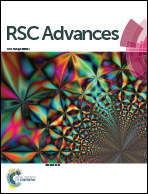Aqueous lubrication and wear properties of nonionic bottle-brush polymers†
Abstract
The usage of aqueous lubricants in eco-friendly bio-medical friction systems has attracted significant attention. Several bottle-brush polymers with generally ionic functional groups have been developed based on the structure of biological lubricant lubricin. However, hydrophilic nonionic brush polymers have attracted less attention, especially in terms of wear properties. We developed bottle-brush polymers (BP) using hydrophilic 2-hydroxyethyl methacrylate (HEMA), a highly biocompatible yet nonionic molecule. The lubrication properties of polymer films were analyzed in an aqueous state using a ball-on-disk, which revealed that BPHEMA showed a lower aqueous friction coefficient than linear poly(HEMA), even lower than hyaluronic acid (HA) and polyvinyl alcohol (PVA), which are widely used as lubricating polymers. Significantly, we discovered that the combination of HA, PVA, and BPHEMA is demonstrated to be essential in influencing the surface wear properties; the ratio of 1 : 2 (HA : BPHEMA) had the maximum wear resistance, despite a slight increase in the aqueous friction coefficient.



 Please wait while we load your content...
Please wait while we load your content...